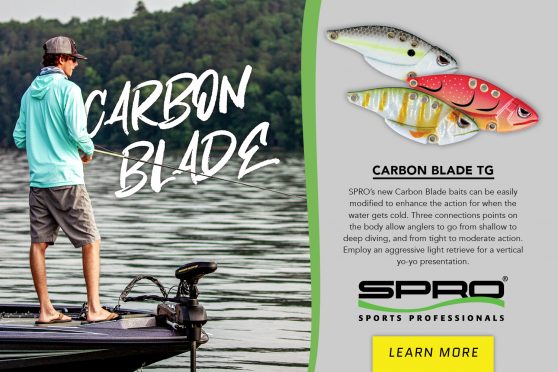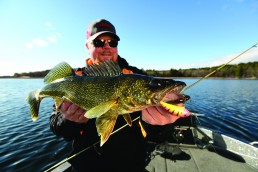Slow Rolling on the Rivers for Walleyes
SHARE THIS POST
 Winter is slowly winding down as the days get longer and overnight temps get warmer. Ice fishing can reach into April, but ice-out on the rivers is what anglers really want once it gets this close to spring. In my part of the Ice Belt in Northern Minnesota, anglers make a run to opening rivers while lakes are still holding their ice. Rivers are the first places anglers use their boats in spring.
Winter is slowly winding down as the days get longer and overnight temps get warmer. Ice fishing can reach into April, but ice-out on the rivers is what anglers really want once it gets this close to spring. In my part of the Ice Belt in Northern Minnesota, anglers make a run to opening rivers while lakes are still holding their ice. Rivers are the first places anglers use their boats in spring.
The Rainy River and the Mississippi River pools 3 and 4 have targets on their back for anglers looking to catch walleyes. Rainy River is catch-and-release-only for walleyes, while Mississippi River pools 3 thru 8 have a 4-fish-limit walleye bag, with minimum of 15” and max of 1 over 20”. Most anglers just want to catch a walleye in their boat on the water as a change of pace from pulling fish through an ice hole.
A Northland Fireball Jig and a minnow is the bread-and-butter of river fishing, drifting downstream at the current speed, making bottom contact every 10 to 20 seconds to keep the lure in the strike zone. Spot-Lock anchoring with a Minn Kota Terrova electric motor allows anglers to vertically jig until the walleye schools pass through.
Some anglers will slowly troll cranks on a long line or leadcore up the river channel. However, a group of us anglers known as the “river rollers” run up and down the river, hitting multiple areas in a run-and-gun bass style, but for walleyes. We do this by strategically pitching crankbaits and slow reeling or (rolling) them through the contact zone.
Cast up close to shore or to structure with a Northland Rumble Shad. I rip it once about 2 to 3 feet while reeling the handle slow, rolling it through the fishy area. The Rumble Shad has a tight wobble like a fleeing baitfish.
With river water temperatures in the low 40s, walleyes are lethargic but still looking to feed. On most casts on structure or in shallow water, the Rumble Shad lip will bounce on the rocks along the bottom. This digging motion definitely wakes up the walleyes. Look for and fish wingdams, log piles, sandbar breaks, riprap and current seams.
Wingdams
A wingdam is a line of rocks piled perpendicularly out 40 to 100 feet from shore to push current to the center of the river. They deflect current back toward the center of the river, minimizing shoreline erosion while allowing barges to safely carry cargo up and down a relatively shallow river by maintaining good depth in the channel. Wingdams not only break current, but hold walleyes on the front, up-current side and sometimes on the end. In front of a wing dam, as the water deflects over and around it, a current seam or slack water is visibly apparent on the surface. This indicates pockets of calm water along the front face, down near the base of the rocks.
This is a great spot to slow roll a Rumble Shad through. Position your boat 30 to 50 feet upriver from the wingdam. Ideally, you want to position in the center, which is better for casting and reaching both ends, as well as behind the boat. Minn Kota trolling motors with Spot-Lock are ideal for wingdam fishing, holding you in great casting position in the current.
Pitch up to the wingdam’s top, then reel your lure back. Angle your casts slightly to the sides to cover area. On a slow retrieve, a Rumble Shad will seductively roll in the current. Casting along the front side, banging the bottom and working a slow curve back to the boat produces strikes.
Some wingdams hold more fish than others. They have more or less current, better access to deep water or might be in the middle of a stretch of wingdams, as opposed to the first or last in a series. Productive wingdams may have an irregular shape, such as a missing spot due to ice, boat traffic or damage to the rocks. Gaps in the wingdam deflect current in a unique manner and hold walleyes around them. This is your target point for casting.
In terms of finding wingdams, most wingdams are marked on LakeMaster maps. Note also the distinctive straight line of roiling water on the surface, extending straight out into the river.
Use your Helix Humminbird Side Imaging on a drive-by to see if there are active fish or unique features. My Humminbird Helix 12 has LakeMaster Maps with high-definition, 1-foot contours that I am able to highlight with colors to identify targeted depths. With the help of LakeMaster cartography, you are able to highlight 1- to 4-foot contours which helps to find the target zone for pitching and rolling cranks.
Are you enjoying this post?
You can be among the first to get the latest info on where to go, what to use and how to use it!
Another handy LakeMaster feature is water level offset. This allows you to change water depths on your map, plus or minus, based on the river levels. River depths tend to fluctuate in spring due to snowmelt and runoff. Adjust the water level offset to depict true depth levels.
Log jams
High waters and floods are constantly eroding the river. Sometimes, trees will pile up in certain river areas. One or more logs along a riverbank may hold fish as the current passes through the logs. Current cuts a scour hole behind the logs; for example, some of the log piles I fish are in 4 to 6 feet of water and have a 10- to 12-foot scour hole behind them.
Position your boat within reasonable casting distance in front of logs. Pitch your Rumble Shad past the logs and slow roll through them. Walleyes will hit it as the Shad is passing through the hole, often before and sometimes right at the logs.
Use a heavier braid like 12- to 16-pound-tesst Sunline SX Green, which will allow you to retrieve lures from snags.
Sandbars
Walleyes also hold on sandbar cuts that break the current and are good ambush spots to intercept minnows. Sandbars are most often located on the slack end of current seams and rivers bends. Sand is nice for rolling crankbaits and digging down the side with fewer snags. Keep in mind that there could be brush or wood partially buried in the sand.
Riprap
Riprap protects the shoreline by piling up rocks to prevent erosion. Rolling cranks along riprap is highly effective in the first 10 feet of the cast. Most fish along these rocky areas are sitting next to shore, so position the boat within 20 feet of the shore. Pitch at an angle up- or downriver, reeling a Rumble Shad down the rocky steps.
Some riprap areas span several hundred feet in length. Most of the fish concentrate in small areas of irregular shape.
Current seams
Current seams are created in a river from neckdowns to wide spots. They can be found in river bends or anywhere something obstructs the flow of current. You can see an actual line where the current speed changes from fast to slow, and the direction of water changes. Walleyes hang in these areas to rest from fighting the current.
Current seams are common near shore and are great places to roll crankbaits through.
Crankbaits and rods
Depending on water clarity, solid color choices are fire tiger, natural perch or bubblegum tiger. The Rumble Shad RSD7 (2 3/4- inch, 1/2-ounce) has a 12-foot. dive depth which is ideal for most situations. The RSD5 (21/4-inch, 3/8-ounce) is perfect for finesse situations.
Rumble Shads float, allowing the lure float freely from some snags. I like to use them on a 7-foot, medium-fast St. Croix Legend Elite baitcast rod with 12-pound Sunline SX1. Spinning rods also work in these situations. However, a baitcaster has more torque for reeling in current.
Load up on Rumble Shad colors and keep your crankbaits safe with the help of an Edge Plano tacklebox system. Temperatures can be chilly and remember to pack your Fish Monkey Stealth Dry Tek gloves. It’s easy to operate a baitcaster with these thin, warm, waterproof gloves.
MWO
SHARE THIS POST
Did you enjoy this post?
You can be among the first to get the latest info on where to go, what to use and how to use it!
Brian 'Bro' Brosdahl
Outdoor communicator Brian “Bro” Brosdahl lives in northern Minnesota. He is a walleye guide in the Cass Lake, Leech Lake and Lake Winnibigoshish areas. He is sponsored by Northland Fishing Tackle, Frabill/Plano, Aqua-Vu, Humminbird/Minn Kota, St. Croix Rods, Ranger Boats, and Evinrude. Guide inquiries: brosguideservice.com. Follow on social media.



